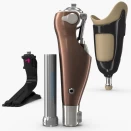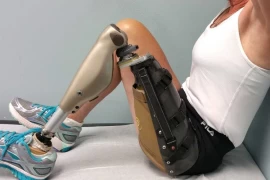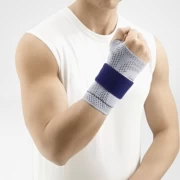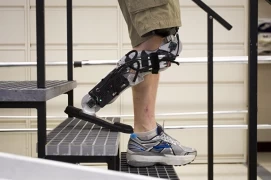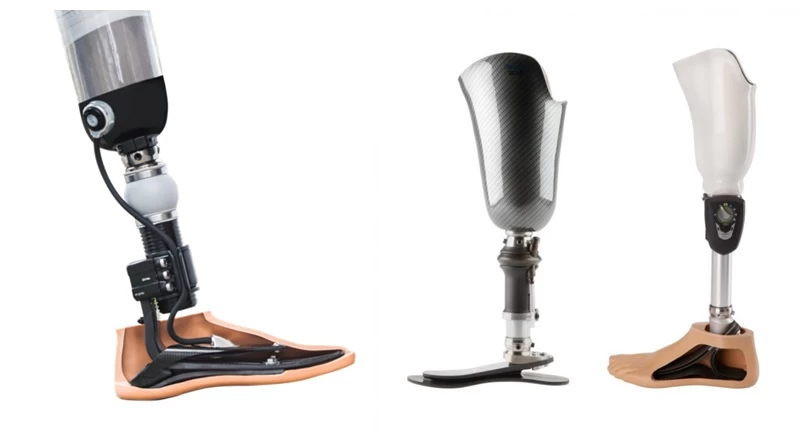
What is Prosthetic Leg and Orthosis? What are the types?
- What is Prosthetic Leg and Orthosis? What are the types?
- PROSTHETIC LEG AND TYPES
- What is Prosthetic Leg?
- How is Prosthetic Leg Produced?
- What are the Prosthetic Leg Types?
- PROSTHETIC FEET TYPES
- ORTHESIS TYPES
- What is Orthotics?
- TYPES OF HAND ORTHESIS
PROSTHETIC LEG AND TYPES
What is Prosthetic Leg?
Prosthetic leg is composed of different materials (carbon, steel) in order to make up for the deficiency caused by the loss of the leg due to diseases, accidents, tumors, war, diabetes (sugar) occurring below the knee, knee and above the knee, and to ensure the ability of the person to continue his daily life. , titanium, silicon) is an artificial limb. We carry out studies based on minimizing the problem of loss of limbs as a result of this disease or accidents, which are common in Turkey, together with our reliable physicians.
How is Prosthetic Leg Produced?
First of all, since the prosthetic leg is specially prepared for the person, there are important considerations in this regard. These are the condition of the part remaining in the body after the cut part, the age, psychology and physical condition of the person. The process begins for the production of the prosthetic leg, which is prepared with all these in mind. Then the necessary body measurements are taken. The most important detail is that the most suitable prosthesis for the remaining part of the body, namely the stump, should be produced so that the patient can adapt.
This procedure, which requires a lot of experience, is carried out professionally by specialist physicians who have achieved success in Istanbul, and the patient's walking status is followed up with exercises after the procedure.
What are the Prosthetic Leg Types?
Prosthetic legs are divided into two as below-knee leg prosthesis and above-knee leg prosthesis. In the above-knee leg prosthesis, there is a knee joint. In below-knee leg prosthesis, the person can use his own knee and there is no joint. Each material used in these prostheses is produced differently from each other. These materials are:
- Active Vacuum Below Knee Leg Prosthesis
- Hydraulic Microprocessor Ankle and Knee Distuclation Prosthesis
- Silicone Linear Below-Knee Leg Prosthesis
- Knee Distuclation Leg Prosthesis
- Above Knee Leg Prosthesis
- Above Knee Microprocessor Leg Prosthesis
- Hip Disturctation Leg Prosthesis
- Modular Knee Leg Prosthesis
- Chopart Leg Prosthesis
- Count Leg Prosthesis
All of these prosthetic leg types are available in Turkey. How Is Prosthetic Leg Care Done?
Since the prosthetic leg is now counted as your own leg, it also needs care. The socket part of the prosthetic leg should be wiped with a slightly damp cloth.
Afterwards, it is necessary to dry it with a dry cloth. It is very important that it stays moist. The prosthesis should be kept away from extremely hot environments. As long as all these steps are done, the advantage of using the prosthesis for a longer time is provided. You can also check or maintain them by visiting www.doktoruzman.com.
PROSTHETIC FEET TYPES
The prostheses applied for the stumps between the knee and ankle are called the Trans Tibial Prosthesis. The ideal stump length preferred for comfort in the use of the prosthesis is amputations (12cm-17cm) made from the middle 1/3 of the Tibia Bone. If the stump is longer or shorter, different alternative methods and different prostheses are used.
This type of prosthesis is needed if the leg is lost below the knee or at the knee level. For these prostheses, classical or vacuum systems with different properties are used.
For successful prosthesis application, it is recommended to use a temporary prosthesis after surgery. Walking and rehabilitation are more successful in amputees using temporary prostheses.
Temporary (intermis) Prosthesis Applications
Temporary prostheses are used as soon as the wound in the stump heals, and when the wound is closed 10-15 days after surgery, the preparatory line temporary prosthesis should be applied.
Temporary Prosthesis;
- It shapes the stump
- Allows early walking
- Individuals return to work early with positive motivation
- Allows pre-assessment of problems in permanent prosthesis
- It enables the user to adapt to the prosthesis.
Temporary prostheses are made of pressure-adjustable air cushion shafts or thermoplastic materials that can be shaped at low temperatures.
The service life of the permanent prosthesis, which is made to the stumps that become tight and shaped after bandaging and stockings and temporary prosthesis application, is longer.
Below-knee prostheses are diversified as "Modular" and "Classic". It is possible to manufacture both of them in different materials and colors.
The most important difference between them is weight, manufacturing technique, comfort of use and price.
Modular Below Knee Prosthesis
Prosthetic carrier parts are made of materials such as steel, aluminum, titanium or carbon, and are obtained by covering the tube (pipe) and modular adapters that adapt to the tube with a cosmetic coating.
Although modular prostheses are more expensive than conventional prostheses in the initial construction phase, they have many advantages.
It allows the prosthesis to be changed due to the easy disassembly and assembly of all modular parts, the possibility of adjustment, and the changes that occur in the stump over time. For this reason, it is both economical in the long term and the service life of the prosthesis is longer.
Socket Types Used in Knee Prosthesis
The prosthetic parts and the prosthetic foot are connected to the stump with a socket made of a hard material called a socket. Different techniques and materials are used to prevent the socket from separating from the stump and sticking to the body. With the development of technology, the methods of attaching the prosthesis to the stump are developing and changing.
In the KBM and PTB (suspension) attachment system, soft materials are used between the stump and the hard socket, and this is called soft socket. In addition to soft sockets, extra stump stockings are used when necessary to connect the prosthetic socket to the body. In recent years, stump suspension systems called Silicone Liner have become much more common. Silicone systems are especially recommended for patients with skin problems and diabetes.
Classic Below Knee Prosthesis
Aluminum, leather and polyester resins are used in this type of prosthesis. Since it is one piece, it does not allow for later adjustments and changes. Classical prostheses are not preferred as much as before due to developing technology and new prostheses.
In order to ensure the attachment of the prosthesis in short stumps, it is necessary to attach the prosthesis to the knee by various methods with the addition of the orthosis knee joint on its side.
ORTHESIS TYPES
What is Orthotics?
Orthosis is the name given to special devices that keep the joints stable or move properly, play an important role in the treatment of some diseases and problems and in the healing process. Orthoses are medical devices that prevent deformities, restrict or control the movements of the joints, and ensure that the muscles and tissues function properly. Orthoses, which are frequently used in the field of orthopedics, have supportive, preventive and protective properties. Orthoses should be determined and used individually according to the condition of the disease or problem.
Types of Orthoses
Orthosis types are divided into two as static orthoses and dynamic orthoses. While static orthoses are orthoses that keep the joints stable or restrict joint movements, dynamic orthoses are orthoses that allow the joints to move and perform their functions. Orthoses are classified as lower extremity orthoses, upper extremity orthoses and trunk orthoses according to the place they are used in the body.
Leg and foot orthoses are used to support the loss of strength in the legs, to provide healing in fractures and soft tissue strains of the leg region, to assist walking, to support the joints in diseases in the joints and to maintain post-operative recovery.
Depending on the patient's condition, the physician decides in which region an orthosis is needed.
Orthoses can be found as ready-made products, and in some cases, they have to be specially designed. Sometimes it is only used to reduce pain and joint movement.
Ankle Orthosis (AFO)
Loss of movement in the foot and ankle, drop foot problem due to nerve damage causes loss of ankle control and walking problems due to neurological reasons. In this case, orthoses extending up to the knee supporting the ankle and leg are used to support ankle movements, prevent deterioration in walking and relieve the person's functional life.
In addition, such orthoses are used in cases such as traumas, ligament injuries or fractures in the foot and ankle region, or in joint problems caused by diabetes and rheumatic diseases in the foot region. The physician should decide which orthosis to use.
In addition, in the foot movement problems caused by cerebral palsy or stroke-induced excessive spasticity in the ankle, custom foot orthoses are produced by the orthotic technicians in the workshop and applied to the patients.
You can access all of these at www.doktoruzman.com.
Personalized Jointless Static AFO
In addition to the loss of strength in the muscles controlling the ankle joint, the lack of movement in the ankle joints or the foot rotates too much during walking, the foot needs to be better stabilized. For this, orthoses that will control the movements of the foot in all three planes, known as jointless AFO, are recommended. The orthosis that is suitable for the patient is determined as a result of the examination and is produced in our AFO workshop, which is approved by the physician.
If the patients using these orthoses use the appropriate orthopedic orthotic shoes, walking will be more controlled.
Conditions of Use;
- Foot drop due to stroke
- Walking problem after head trauma
- Drop foot with spasticity
- Children with Cerebral Palsy and walking problems
- Drop foot patients due to overweight neuropathy
- Ankle deformity
- Charcot foot
Custom joint AFO
These types of orthoses are used to support the movement and to make the foot more free in walking when there is a loss of strength that will cause foot drop without limitation of ankle movements or excessive spasticity. After evaluating the patient's walking, the physician and technician decide which joint to use and how much movement will be allowed in which directions in the joint.
In addition, the orthosis can be made by hardening with carbon in addition to the plastozote material. Conditions of Use;
- Supporting walking in children with Cerebral Palsy
- Drop foot caused by neuropathy
- Drop foot due to lower motor neuron damage
- Charcot Marie Tooth patients
Leaf Spring AFO
Although this orthosis is a lightweight product made of polypropylene material, it cannot provide adequate support for people with severe foot drop and overweight. It is readily available for different foot lengths. It is used to control the foot in case of mild drop foot problem due to its very thin structure that allows movement in the ankle. The foot is prone to plantar flexion and provides passive grip.
Conditions of Use;
- Foot control in the early post-stroke period
- Stroke patients with mild drop foot problem
- Control of loss of strength in the ankle due to diseases such as multiple sclerosis
Carbon Front supported AFO (Carbon GRAFO)
For ankle orthoses, the support of the orthosis can be planned in front rather than in the back. The reason for this is to support the weak knee muscle during walking and prevent bending in the knee. The front support of the orthosis in walking, which is called the bent-knee gait seen in children with Cerebral Plasy, makes walking better by supporting the quadriceps muscle during walking. These orthoses made of carbon material are both lighter and more durable. It provides more stability and balance, especially in bilateral involvement. Carbon can be made thicker and more rigid and more controlled. It is available in different sizes according to the right or left shoe size. However, according to the patient, it will be necessary to make adjustments in the heel and bands.
Conditions of Use;
- Children with Cerebral Palsy who walk with bent knees
- Polio and postpolio patients to support weak quadriceps muscle
- Incomplete paraplegic patients
- Charcot Marie Tooth patients
Carbon Easy Walk AFO
Easy Walk, a carbon-ready ankle orthosis, is much more comfortable and convenient than similar products on the market with its structure that grips the leg from behind. Trying on this orthosis on the patient and making a slight heel raise to the heel when necessary makes walking better and more comfortable. You can get more information from our technician for this product, which is sold in different 3-4 sizes, right and left ready according to the foot number of the patient, by calling our company.
Conditions of Use;
- Drop foot due to stroke and multiple sclerosis
- Gunshot injury, injection-induced herniated disc, or operation-induced peroneal nerve injury
- Charcot joint
- Providing walking with prosthesis with anterior filling in partial foot amputations
Silicone Ankle Orthosis (SAFO)
A very comfortable, balanced gait is provided for the patient with this type of silicone orthoses, which is the lightest in ankle orthoses and provides the most support for the foot and leg. Especially in case of bilateral drop foot or bilateral ankle problem, the person's posture changes with sensory inputs known as proprioception from the ground. These orthoses are very effective for increasing balance by taking This orthosis, which is produced in England by Dorset Orthopedics, is imported by our company. It can be ready for different foot sizes, right or left, or it can be produced specially according to the foot size and skin color of the person when requested.
SAFO is also available for children in different colors and sizes. Conditions of Use;
- Charcot Marie Tooth patients
- Drop foot caused by stroke, brain trauma
- Ankle control in children with Cerebral Palsy
- Drop foot in neuropathy and polyneuropathy patients
Dyankle Ankle Orthosis
In this orthosis, ankle plantar flexion is controlled while also supporting the outward rotation control of the ankle known as eversion of the foot with ankle bands, making the foot more stable and keeping the foot in a neutral position during the swing phase of walking and making the foot stable and controlled before landing on the ground. is brought into supination.
This orthosis, which is made of ready-made and plastic material, is also used in the treatment of ankle ligament injuries. It is produced in different sizes and ready for right and left.
Conditions of Use;
- Anterior ligament rupture
- After postoperative ligament repair
- Lower foot
Foot Up
It is used to prevent the foot from falling by connecting to the foot or shoe with a simple ankle band. This orthosis can be used for very mild ankle control loss.
However, sometimes patients can use this orthosis for a short time when they do not want to wear orthoses or orthopedic shoes while participating in social life. In overweight people, severe low foot or bilateral low foot is inadequate and knee, hip and low back problems may develop if this orthosis is continued to be used.
Conditions of Use;
Diseases that cause mild foot drop
ROM Walker
It is aimed to prevent the movements of the foot and ankle with this walking boot, which is produced in short and long models that surround the entire foot and ankle. It provides stabilization both after trauma and after the operation and allows walking with a comfortable and comfortable support to the foot. Additional elevations to the heel area of the foot provide the opportunity to adjust the pressure and angle to be given to the heel with wedges. It is produced ready-made in right and left and different shoe sizes.
Some models have ankle joint and the plantar flexion angle can be adjusted. The physician decides on the appropriate walking boot.
Conditions of Use;
- Ankle tendon and ligament injuries, sprain
- Forefoot and metatarsal injuries and fractures
- Conservative and post-surgical treatment of Achilles tendon injury
- Stable fractures
- Treatment of pressure sores and ulcers such as diabetes in the foot
Aircast Air Stirrup Ankle Orthosis
The ankle is often subject to sprains and ligament injuries. Sometimes, ankle injuries become chronic and are prone to sustained sprains and trauma, called instability. In this product, soft pads are used as edema control by cooling when desired, and the ankle is stabilized with adjustable velcros on the foot, but the movement of the foot is preserved at certain angles.
Conditions of Use;
- Ankle distortions,sprain
- Side ligament injuries
- Chronic ankle instability
Elastic Ankle Support
After injury, edema develops in the tissues around the ankle and compression is appropriate. Textile product with antibacterial compression effect is produced in different sizes and dimensions. In accordance with the anatomical structure, sometimes a pad can be placed around the wrist.
Conditions of Use;
- Support after trauma or operation
- Osteoarthritis, joint-induced edema in the case of arthritis
- Tendinitis
- Ankle strain and sprain
- Ankle pain
Ankle Knitted Material Model
The wristband, which is made of knitted breathable textile material, is used to support muscle strength and reduce pain, as well as stabilization and functional recovery.
Conditions of Use;
- Ankle instability
- Ankle edema
- Arthritis
- Post-traumatic protection
Soft Wristband
This bracelet, which aims to prevent foot sprains, stabilize the ankle, and reduce pain, is tightly contacted with the laces. It also allows doing sports activities. Providing comfort along with support is an advantage.
Conditions of Use;
- Foot sprains
- Inadequate ankle control
- Sprain
- For sports protection
Adjustable Ankle support
With cross tension scarves, the ankle is controlled and the person's ankle circumference is supported. The heel is exposed, lightweight and suitable for use with most shoes. The straps are crossed at the ankle and the wristband does not slip. It is possible to use it by injury during and after the swelling period. It is suitable for both feet and it is an advantage that it is produced in one size.
Conditions of Use;
- Support the ankle
- Edema control
- Situations where motion-controlled load distribution is desired
Foot Arc Support
It is aimed to reduce the pain with this supportive band in case of collapse of the arch of the foot or pain in this area.
Conditions of Use;
- Pain in the sole of the foot
- Excessive foot arch
Night Rest Splint
In cases where extreme pain and difficulty in walking develop on the sole of the foot, the foot should be kept in a resting position at night. Stretching of the sole of the foot, known as the plantar fascia, and an adjustable level of flexion are recommended for the treatment of the patient. It is possible to adjust the foot at the desired angle by supporting it with soft pads.
Conditions of Use;
- Plantar fasciitis
- Repeated injuries of the lower extremity
- Achilles tendinitis
- Low foot
- Heel pain
TYPES OF HAND ORTHESIS
Orthotics; Orthopedic devices are devices that are worn externally to the body, such as an orthopedic device, vehicle or splint, used to improve the function of movable body parts, support or correct weak muscles or joints. What is expected from the orthosis is to protect the damaged tissues, facilitate movements, support healing and reduce pain.
Orthoses are named according to the body parts they are used in. Such as hand orthoses, knee orthoses, neck braces etc. Some orthoses are ready-made and can be purchased in suitable sizes. Sometimes, it should be produced by the orthotic technician, according to the physician's prescription.
They are orthoses prepared to control pain, correct movement and increase function in problems in the arms and joints. Fractures, nerve damage, ligament and tendon injuries, burns, frostbite, pain, limitation of movement and deformity in the musculoskeletal system caused by diseases or trauma in this region are treated with the orthosis.
Finger Orthosis
Static finger splints restrict movement and provide comfort to the patient with their ergonomic supports.
Where it is used:
- Tendinitis
- Mild to moderate strain and sprain
- Post-injury pain and swelling
- Broken dislocations
- Tendon ruptures/ cuts/ tears
- Rheumatoid arthritis, osteoarthritis
- Post-operative support
Mallet finger splint
It is used in hammer toe deformity due to extensor tendon injury/rupture. The middle joint (PIP) is free, while the end joint (DIP) is fixed.
baseball finger splint
It is used to keep the finger in extension in case of extensor tendon injury/rupture.
Toad finger splint
It is used to hold the finger in the desired position.
Oval 8 finger splint
It is used to support the needed joint, to keep the finger in the desired position.
finger bands
It is used to fix the finger.
Dynamic finger splints
It provides full range of motion of the joints by assisting the extension (opening) or flexion (bending) movements.
HAND PROSTHESIS TYPES
Arm and hand amputations, called upper extremity, are performed due to traumas, congenital anomalies, electric shock and tumors. When deciding on amputation, the physician pays attention to retain as much function as possible. For example, the function of the thumb alone accounts for 50% of the entire function of the hand. In upper extremity amputation, the levels are classified as partial hand and finger losses from hand to shoulder, above-elbow amputation, below-elbow amputation, and entire arm loss from shoulder level.
Upper extremity amputations negatively affect a person's activities of daily living. Especially the loss of the dominant extremity, which is called the dominant extremity (it is different for right-handed and left-handed), means more functional disability and disability.
Partial Hand and Finger Prosthesis
In cases where a part of the hand and fingers are lost, it may be possible to make silicone or mechanical prostheses, depending on the level and technical situation. The decision on this issue is determined by the prosthetic technician after the evaluation of the patient.
Silicone Finger Prosthesis
Finger and hand prostheses; Since there are visible organs compared to foot prostheses, color tone adjustment should be made on the user in order to be more aesthetically compatible and to make the skin color match closest to the skin of the prosthesis wearer. Although prostheses made in this way are very close to reality, it is possible to apply nail polish on hair, nails and nails.
ProDigits Partial Hand Prosthesis
The ProDigits prosthesis, which has gripping, bending and holding features, allows the hand to function as a normal hand in cases of partial loss of the hand. ProDigits is a very special device designed for patients who do not lose their entire hand but have problems with losing a part of it. Therefore, it is no longer a dream to say that the technology offered for these patients has completely changed.
In cases where the person does not have a thumb or any other finger, even very simple operations such as holding a cup or taking a fork can become difficult. Thanks to the ProDigits device developed by experts, our patients can say goodbye to such difficulties.
Before using ProDigits, the patient must be subjected to a clinical examination by experts. Therefore, if you have any problems with your fingers, you can remove the obstacles in your life by contacting our representative in Turkey.
The sockets of the device are designed separately and specially for each patient. Thanks to these sockets, the patient can easily adapt to the ProDigits device.
The device can be operated via power sensitive units or electrodes. Before signal reception can be detected, signal points are determined.
It can be controlled remotely with a software called BioSim. Thanks to the detailed options of the device, the patient can switch to modes where he can type on the computer and press the keypads of the phone whenever he wishes.
It can also be used with a coating on ProDigits. Thanks to this state-of-the-art glove coating, the device can be protected against external factors such as moisture and dust and can be used for a lifetime.
